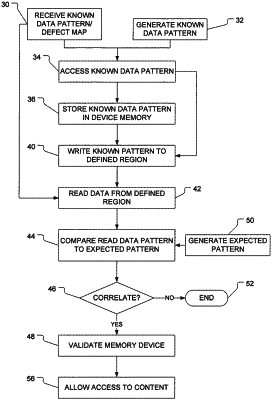| CPC G06F 21/44 (2013.01) [G06F 21/10 (2013.01); H04K 1/00 (2013.01); H04L 63/0428 (2013.01); H04L 67/06 (2013.01); H04L 67/108 (2013.01); H04L 67/104 (2013.01); H04L 2209/60 (2013.01)] | 47 Claims |

|
1. A method of validating a content memory device communicatively coupleable with a playback device, comprising:
reading a unique data pattern from a region of the content memory device, the region having content memory device inherent random physical manufacturing defects identified in a defect map, the unique data pattern being a first data pattern written to the region and altered by the content memory device inherent random physical manufacturing defects in the region identified in the defect map;
validating the content memory device based at least in part upon the unique data pattern, the written data pattern, and the defect map; and
wherein the written data pattern is also stored in a device memory within the playback device and validating the content memory device comprises accessing the device memory within the playback device to retrieve the stored data pattern.
|